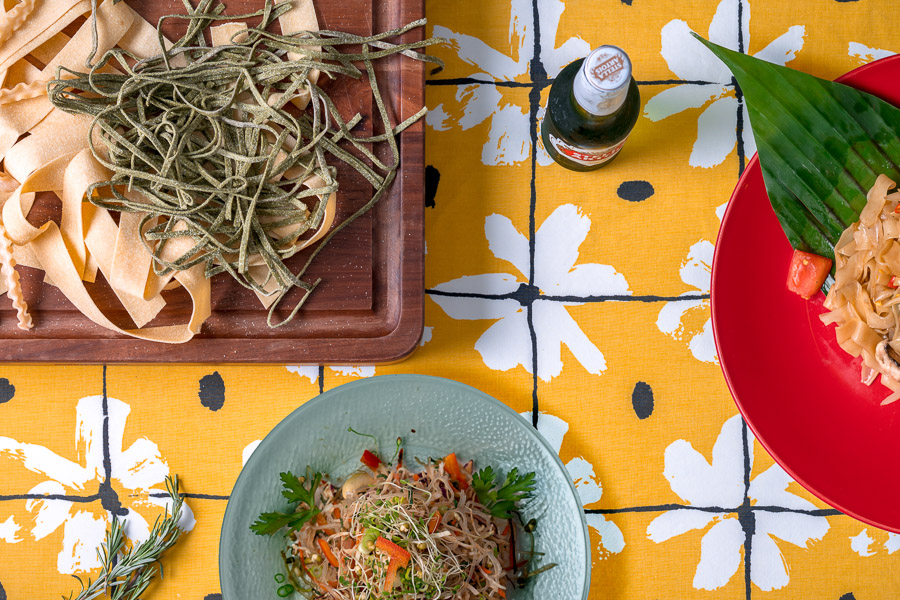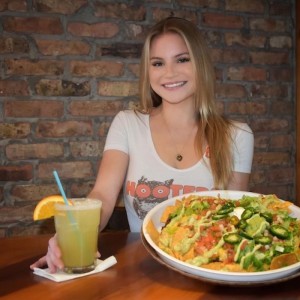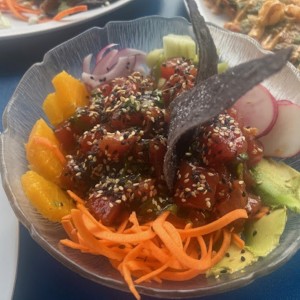Pinning down food trends involves more than just bringing up the weird and the wild—though the flavor must pique one’s sense of fascination and delight, foodie forecasters look for variables such as marketability and cultural practice. How are certain ingredients prepared? Why does one element seem to be elbowing out a similar concoction? While we may never know exactly why we like what we like, there’s no denying food trends come in waves, so why not ride the swell? Come sit at our table while we flesh out national trends seen on the local stage.
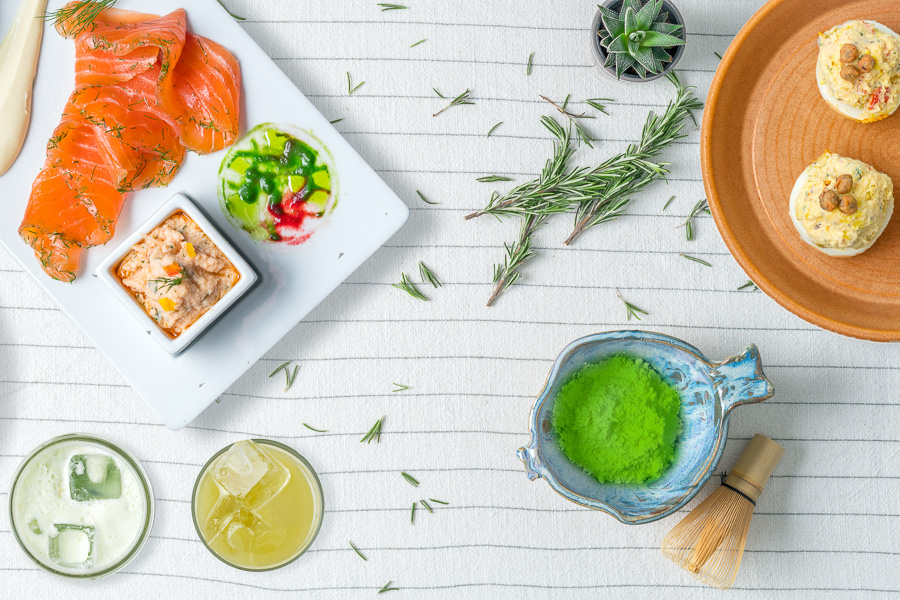
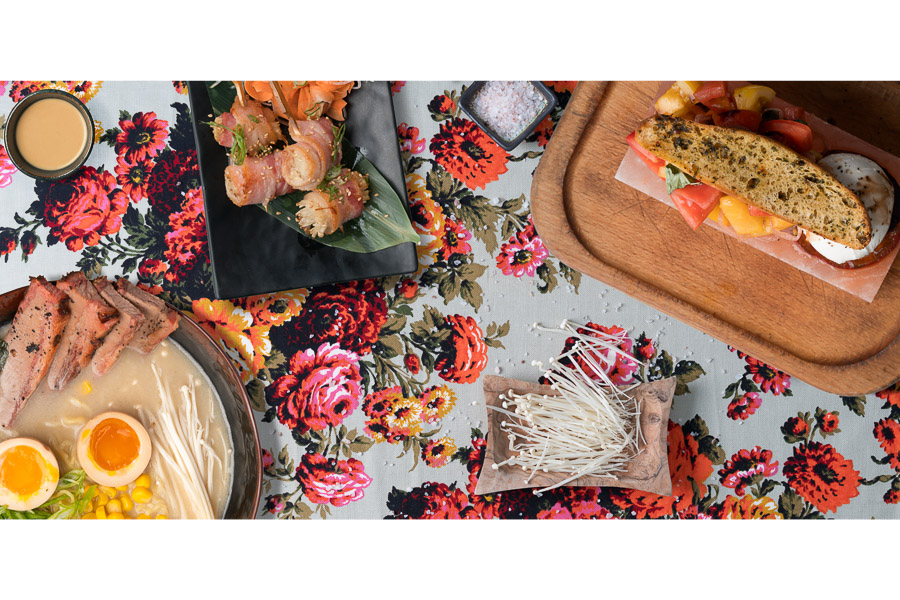
NOODLES
Ah, the inimitable noodle—its uses innumerable, its flavor nonpareil. Cultures across the world have adopted their own form of the sinewy stuff, adding and subtracting base layers to suit the essence of national character. The Japanese buckwheat soba noodle dates back to the Tokugawa period beginning in 1603; Pad Thai rice noodles were used in the 1930s and ‘40s by Thai Prime Minister Plaek Pibulsonggram to westernize, modernize and unite the country; Greek orzo and German spaetzle take the noodle to new shapely heights; and of course, what would Italy be without pasta? And, believe it or not, the first reference to boiling pasta noodles appears in the Jerusalem Talmud (completed around the 4th century). While noodles have clearly been “trending” for centuries, chefs continue to find new ways to interpret and create the lanky worldwide sweetheart.
Spotted @ Peperonata Pasta Pappardelle, Mafalda and Spinach Fettucini
Pasta is a staple in Italy, dating back to Sicily in 1154 and is made from unleavened dough of wheat flour, water or eggs. The Peperonata people make their pasta fresh by hand with the help of a noodle machine, the store carrying over 25 noodle shape variations.
Spotted @ Beauty of Sprouts Kelp Noodle Pad Thai
Vegan, dairy-free and gluten-free, this noodle dish is free of oil and salt, all the primary spice deriving from fresh ginger and tamarind. The noodles themselves are made from sea kelp, a crunchy-ish, angel-hair-pasta-ish, nutrient-rich vegetable that can be compared to zoodles (zucchini noodles).
Spotted @ Drunken Poet Pad Kee Mao
Also called “drunken noodles,” pad kee mao finds a base in broad rice noodles that get stir fried with soy sauce, fish sauce, garlic, basil, onions, tomatoes and chili, giving the noodles a distinct chewiness and spicy kick.
SMOKED FISH
Smoked fish has always been trendy in Florida, our easy access to just-caught seafood probably to blame, along with easy outdoor prep and unpretentious serving style (aka on a cracker). Yet, while the original go-to for dips and whole-fishes was once mullet (found jumping willy-nilly in bucking schools along the Gulf Coast), chefs now find excuses to take their smokers to task with new fishy varietals. And the smokers they use are often off-the-cuff creations made directly in the kitchens, with wood chips and fragrant herbs placed underneath the filet then burned or heated with water, letting smoke ripple out into the fish—forget the days of fishing village smokehouses.
Spotted @ Shore Diner Smoked Salmon Spread
Smoked in-house over a bed of rosemary and oak, the Faroe Island salmon featured here can stand alone—fatty and delicious. The dip mixes up the smoked salmon with olive oil, Dijon mustard, dill, chives, sweet peppers and home-made mayo for a combo that is smooth and spreadable. The smokiness is accompanied—but not overshadowed—by strips of impossibly tender salt- and sugar-cured gravlax and
fingerling potatoes.
Spotted @ Louies Modern Smoked Trout Deviled Eggs
When the trout arrives from Idaho, it first gets butterflied, then smoked over oak wood and finally chopped before getting mixed with a house-made relish for the deviled eggs. An unexpected sweetness comes from the egg yolk blend, primarily from the marriage between Tabasco, dry mustard, mayo and Peppadew peppers (sweet piquanté peppers from South Africa). Crispy capers brined in buttermilk cornstarch and fried bring out the earthy undertone of the smoky fish.
MATCHA
Recently billed as the “new” coffee, even the most devout espresso lovers are ditching the brown for the green. The powdered tea comes from finely ground leaves, forming a hot drink by whisking with a bamboo brush until frothy. Traditionally prepared during a centuries-old Japanese tea ceremony called chanoyu, preparation and presentation matter, the process designed to promote meditation and Zen. Matcha is an antioxidant powerhouse full of polyphenols, more potent than regular green tea, and thought to protect against everything from heart disease to cancer, prevent wrinkles and boost metabolism. The best part: it contains caffeine—around the same amount as a cup of brewed coffee—without the buzz, the amino acid within the jewel-green powder called L-Theanine giving you both stimulation and calm for an overall sense of wellbeing.
Spotted @ The Tea House Traditional Matcha Green Tea
While only available every now and again, the traditional matcha at the Tea House is unbeatable. They’ll whisk it up right in front of you for a hot treat.
Spotted @ PERQ Coffee Bar Iced Sweet White Matcha and Matcha Lemonade
In true Perq form, the baristas have added matcha to their roster of caffeine-heavy brews. While the traditional form isn’t on the menu, find the matcha sweet white (basically a latte with whole or almond milk, subbing matcha powder for espresso shots) hot or iced and the matcha lemonade—tart and tangy.
HIMALAYAN SEA SALT
This rosy-hued, flushed halite has attained a somewhat cultish status, causing hipsters and executive chefs alike to shun crude white table salt, noses collectively turned up at the mention of Morton. Mined at the Khewra Salt Mine in Pakistan almost 200 miles from the Himalayas, the rock salt was once buried under snow and ice for millennia after crystallized sea-salt beds in the mountains were drowned in lava. Modern-day pollution never touched the pink gold, allowing the salt to be left in its unrefined, pure state. Containing around 80 minerals including phosphorus, bromine, boron and zinc, the purported health benefits of the combination are myriad. Because the crystals are stone-ground and larger than fine table salt, each bite contains much less sodium.
Spotted @ Crop Juice White Chocolate Almond “Mylk”
This creamy concoction wouldn’t be what it is without the dash of Himalayan salt balancing out the hazelnut silk butter, vanilla and cinnamon. The health benefits of hemp seed and maca root join those of the rosy salt.
Spotted @ Louies Modern Burrata on Himalayan Salt Plate
Chef Jose Rojas punches up his burrata not only with local heirloom tomatoes, pickled cipollini onion and a focaccia stick precariously perched on top, but also with a mega slab of Himalayan sea salt. The pink “plate” is less about a quick salt fix and more about a well-rounded flavor—the salt soaks into each ingredient, each bite getting progressively more yummy.
ENOKI MUSHROOMS
Known by a variety of names—enokitake, velvet foot, golden needle, snow puff mushroom, winter fungus and lily mushroom—the enoki mushroom is immediately recognizable, with its lithe slim stalk and miniature white cap on top. The semi-sweet, mild and slightly chewy-crisp mini ‘shrooms generally take up residence in Asian soups and stir-fries, their clusters ideal for pairing with ramen and udon noodles. The bouquets have been cultivated for hundreds of years, cited as holding the ability to prevent cancer—tests on animals have indicated the possibility for the enoki to be used in the development of vaccines and cancer immunotherapy.
Spotted @ JPAN Bacon Wrapped Enoki Mushrooms, Brisket Ramen
While Jpan Owner Daniel Dokko still serves enoki mushrooms in their most recognizable abode—ramen bowls—he says the “golden needles” have such a distinct taste, he wanted to play a little. Thus, the bacon wrapped ‘shrooms fired on a robatayaki (or just robata) grill came to be on his Jpan UTC menu. The bite-sized morsels live on a skewer, slow-grilled over hot charcoal and are served sizzling.





